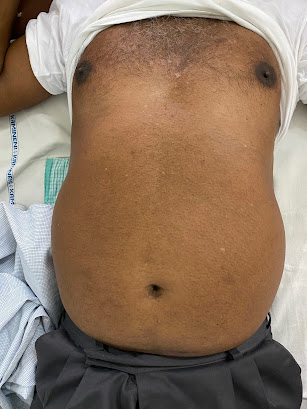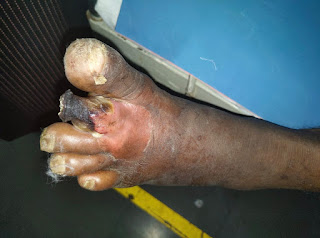SrideviTripuraneni
Roll no.138
1)Anatomical diagnosis -? Renal -Glomerulosclerosis Etiological diagnosis - ?? Nephrotic syndrome secondary to the diabetic nephropathy or CKD.
2)Reasons for I) Azotemia : impaired renal excretion of urea and creatinine secondary to CKD.
II) Anemia : decreased erythropoietin.
III) Hypoalbunemia: capillary basement membrane and podocytes damage.
IV) acidosis: acidification of urine is lost.
3) Rationale : syp potchlor was given because of the hypokalemia.. Inj. NaHCO3 was given because of metabolic acidosis ..Insulin and antihypertensives are given because known case of DM and HTN. Orofer XT was given because of anemia.. Inj. Lasix was given to decrease her volume overload. Spironolactone was given it was a potassium sparing diuretic.Calcium was given to the patient because of hypocalcemia secondary to CKD. Indications of NaHCO3:metabolic acidosis in cardiac arrest, Tricyclic antidepressants, aspirin and phenobarbitone overdoses, Hyperkalemia, Crush injuries, C/I in certain conditions because of adverse reactions like Hypernatremia, metabolic alkalosis, cellulitis, seizures, Tetany, sodium retention, peripheral edema.
4) indication of dialysis in this pt: worsening of SOB secondary to metabolic acidosis with Anuria not resolved with high ceiling diuretics...Crucial factor: pt became symptomatic on 3rd day....
5) Causes of same condition :
primary : Minimal change disease, Focal segmental glomerulosclerosis, Membranous nephropathy.
Secondary : DM, SLE, HIV , Viral hepatitis, malaria, amyloidosis, Sarcoidosis, Drugs : Nsaids, gold, pencillamine Cancer: Hodgkin's and non Hodgkin's, solid tumours of GIT, RCC and lung.
6)expected outcomes of ckd patients depend upon age,genes,associated co morbidities This patients condition may deteriorate due to pleural effusion
https://www.ncbi.nlm.nih.gov/pmc/articles/PMC5261605/
7)association of ckd with hrpef
Activation of raas system
Anemia
Hypercalcemia
Hyperphosphatemia
Uremic toxins .these critically discuss the potentail contribution to coronary dysfunction, left ventricular stiffening and delayed left ventricular relaxation
8)efficacies of drugs over placebo in anaemia : 117 patients received oral ferric citrate and 115 patients received placebo for a 16 week randomized period... 52.1% patients receiving ferric citrate achieved primary endpoint of increased HB levels ..comparing to 19.1% patients receiving placebo.. Overall in pts with CKD.. Found Oral ferric citrate found to be safe and efficacious treatment for IDA.. Another trial : between Ferumoxytol and placebo for anemia in IDA and GI disorders... A trail was performed in 231 pts with IDA and GI disorders vs placebo in pts who had failed or were intolerant to oral iron therapy.... Results : pts with IDA receiving Ferumoxytol achieved a levels of >_ 20g/dl in HB vs placebo pts. https://www.dovepress.com/ferumoxytol-versus-placebo-in-iron-deficiency-anemia-efficacy-safety-a-peer-reviewed-fulltext-article-CEG
https://www.uspharmacist.com/article/oral-iron-supplements-found-safe-effective-in-users-with-ckd
9)Anaemia contributes to the impairment of health-related quality of life (HRQoL) in patients with CKD [7]. Its impact on patients’ HRQoL burden is exacerbated by reduced physical capacity and energy levels among these patients.
10)Malnutrition is an important complication in CRI patients and ESRD patients on dialysis. SGA is a reliable method of assessing nutritional status. Most important is the fact that it can detect the changing trend of nutritional status, which may be missed by one-time anthropometry and biochemical methods.
11)this 58M had history of fever with cought and elevated tlc with indiacates renal acute kidney injury.As well there is no albuminuria,no edema
Question #2:
1) The first case presented with anasarca, anuria with mild hematuria, and abdominal pain with severe proteinuria diagnosed as Nephrotic syndrome and the second case presented with anuria and pain abdomen which was diagnosed as Prerenal AKI. The only drug that varied in treatment was T.Piptaz given in the second case. The expected outcome in the first case is resolution of symptoms but persistent CKD which will require dialysis whilst the second case has a very good expected outcome with resolution of all damage.
2) I don't agree with the provisional diagnosis of Prerenal AKI since there is no hypovolemia so the AKI could be due to post-operative complications of her spine surgery.
3) On ultrasound, the right kidney is larger than the left kidney and there is corticomedullary differentiation. The right kidney is larger due to injury predominantly in the right kidney but there is no sonological abnormality. Therefore this doesn't explain the cause for her renal failure.


Comments
Post a Comment